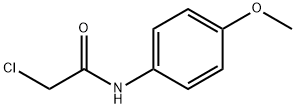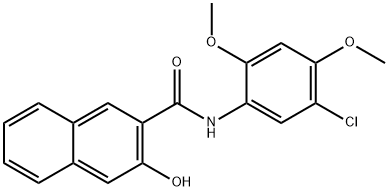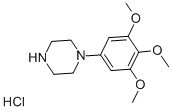P-ANISIDINE HYDROCHLORIDE
Synonym(s):p-Anisidinium chloride;p-Anisidinium chloride, 4-Methoxyanilinium chloride
- CAS NO.:20265-97-8
- Empirical Formula: C7H10ClNO
- Molecular Weight: 159.61
- MDL number: MFCD00036388
- EINECS: 243-657-0
- SAFETY DATA SHEET (SDS)
- Update Date: 2025-01-27 09:38:02

What is P-ANISIDINE HYDROCHLORIDE?
Chemical properties
BROWN-GREY CRYSTALLINE POWDER
General Description
Grayish-black crystalline solid or brown crystals.
Air & Water Reactions
P-ANISIDINE HYDROCHLORIDE may be sensitive to prolonged exposure to air and light. Insoluble in water.
Reactivity Profile
An acidic organic salt. Materials in this group are generally soluble in water. The resulting solutions contain moderate concentrations of hydrogen ions and have pH's of less than 7.0. They react as acids to neutralize bases. These neutralizations generate heat, but less or far less than is generated by neutralization of inorganic acids, inorganic oxoacids, and carboxylic acid. They usually do not react as either oxidizing agents or reducing agents but such behavior is not impossible.
Health Hazard
ACUTE/CHRONIC HAZARDS: When heated to decomposition P-ANISIDINE HYDROCHLORIDE emits very toxic fumes.
Fire Hazard
Flash point data for P-ANISIDINE HYDROCHLORIDE are not available. P-ANISIDINE HYDROCHLORIDE is probably combustible.
Safety Profile
Questionable carcinogen with experimental carcinogenic and tumorigenic data. Mutation data reported. When heated to decomposition it emits very toxic fumes of NOx and HCl.
Properties of P-ANISIDINE HYDROCHLORIDE
| Melting point: | 216-219 °C |
| storage temp. | Store below +30°C. |
| solubility | DMSO (Slightly), Methanol (Slightly) |
| form | Crystalline Powder |
| color | Off-white to pinkish to gray-brown |
| Water Solubility | within almost transparency |
| Stability: | Hygroscopic |
| CAS DataBase Reference | 20265-97-8(CAS DataBase Reference) |
| EPA Substance Registry System | p-Anisidine hydrochloride (20265-97-8) |
Safety information for P-ANISIDINE HYDROCHLORIDE
| Signal word | Danger |
| Pictogram(s) |
 Exclamation Mark Irritant GHS07  Health Hazard GHS08 |
| GHS Hazard Statements |
H315:Skin corrosion/irritation H317:Sensitisation, Skin H319:Serious eye damage/eye irritation H334:Sensitisation, respiratory H335:Specific target organ toxicity, single exposure;Respiratory tract irritation |
| Precautionary Statement Codes |
P261:Avoid breathing dust/fume/gas/mist/vapours/spray. P280:Wear protective gloves/protective clothing/eye protection/face protection. P301+P312:IF SWALLOWED: call a POISON CENTER or doctor/physician IF you feel unwell. P305+P351+P338:IF IN EYES: Rinse cautiously with water for several minutes. Remove contact lenses, if present and easy to do. Continuerinsing. |
Computed Descriptors for P-ANISIDINE HYDROCHLORIDE
New Products
Trans-methyl 4-aminocyclohexane- carboxylate HCl 3-(hexyloxy)-4-(pyridin-3-yl)-1,2,5-thiadiazole 2-Propanamine, 1-chloro-, hydrochloride (9CI) 3-Pyridineacetonitrile, α-hydroxy- 3-Iodophenylacetic acid (S)-1-Boc-3-methanesulfonyloxy-pyrrolidine Cyclohexane, (2-propynyloxy)- 3-Bromobenzaldehyde, 95% 2-Naphthol, 98% Cysteamine hydrochloride, 98% Copper(II) bromide, 98% 1-Chloro-2,4-difluorobenzene,98% Dodecylbenzenesulfonic acid, 95% L-Glycine methyl ester.HCl Fmoc-L-Tyr(tBu)-OH Calcium Alphaketoglutarate* H-Ser(t-Bu)-Ser(t-Bu)-Gly-OH Fmoc-Ser(tBu)-Ser(Ψ(Me,Me)pro-OH Triphosgene 5-Cyanophthalide 10-Methoxy-5H-dibenz[b,f]azepine L-Glutamic Acid Dimethyl Ester Hcl 2-AMINO-3,5-DIBROMO BENZALDEHYDE [ADBA] 4-(3,4-Dichlorophenyl)-3,4-Dihydro-N-Methyl-1-(2H)-Naphthalenimine (Schiff Base)Related products of tetrahydrofuran








You may like
-
 p-Anisidine Hydrochloride CAS 20265-97-8View Details
p-Anisidine Hydrochloride CAS 20265-97-8View Details
20265-97-8 -
 p-Anisidinium chloride CAS 20265-97-8View Details
p-Anisidinium chloride CAS 20265-97-8View Details
20265-97-8 -
 15761-38-3 N-Boc-L-Alanine >98%View Details
15761-38-3 N-Boc-L-Alanine >98%View Details
15761-38-3 -
 873-74-5 4-Aminobenzonitrile 99%View Details
873-74-5 4-Aminobenzonitrile 99%View Details
873-74-5 -
 872-85-5 99%View Details
872-85-5 99%View Details
872-85-5 -
 N,N-Carbonyl diimidazole 99%View Details
N,N-Carbonyl diimidazole 99%View Details
530-62-1 -
 3- Pyridinecarboxaldehdye 500-22-1 99%View Details
3- Pyridinecarboxaldehdye 500-22-1 99%View Details
500-22-1 -
 80841-78-7 DMDO-Chloride 92%View Details
80841-78-7 DMDO-Chloride 92%View Details
80841-78-7
